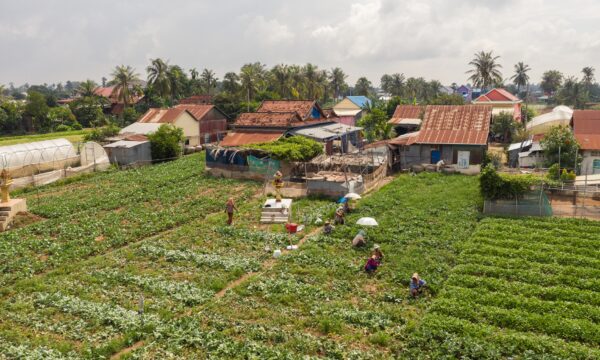Parthenium hysterophorus, or parthenium weed, is highly invasive in many parts of the world. It is native to Central and South America but is now found in Asia and Africa, among others. In Australia, it has caused millions of dollars in crop yield losses. This is because the weed can produce prolific seeds, germinate, and grow rapidly. Parthenium also produces biochemicals that can suppress the growth of surrounding crops.

In Pakistan, parthenium was introduced in the 1980s and has since impacted crops. One affected crop is maize, a key species with around 1.32 million hectares of production land in Pakistan. The effect of parthenium is very dependent on the context of the area and additional factors such as infestation density and weed-crop competition dynamics.
Discovering more about these factors can determine how parthenium impacts maize yield loss. Specifically, the question of how the density of parthenium weed affects the production of maize can be answered.
Estimating the impact on maize production
In a CABI-led study, researchers from the University of Shiraz and the University of Neuchâtel recently published an analysis that assessed maize crop losses caused by parthenium weed through a 2-year experiment. The team measured the yield of different maize crop plots with differing parthenium weed densities at CABI’s centre in Rawalpindi, Pakistan. The maize density stayed the same throughout the experiment.
Before the experiment, they predicted that higher parthenium densities would result in higher yield loss. They also hypothesized that they could estimate a minimum threshold for the weed density that would still be economically positive.
Results showed that increased weed competition led to a decline in all metrics of maize yield. The crop yield was highest in plots without parthenium (0), and the yields for the 0.5, 1, 2, and 4 plants per m2 plots decreased by 14, 22, 29, 38, and 46% respectively. It could be seen that there was a rapid increase in effects on maize yield. However, these started to saturate at four plants per m2.
Parthenium weed and maize crop competition
This study highlights that parthenium weed is highly competitive against maize. Existing research shows a linear decrease in maize yield, but this study demonstrated nonlinear behaviour, such as the rate of yield loss. This could suggest that the weed is also competing with itself for resources.

The number of grains per cob also reduced with increasing weed density. One possible reason for this is that competition was most significant during the ear development and fertilization stages.
Competition periods could also have been longer at higher parthenium densities. Parthenium could take more nutrients at the rhizosphere (the soil surrounding plant roots where essential interactions for plant growth happen) and thus grow faster.
Other adverse effects of parthenium weed
Competition for resources is not the only way parthenium can impact neighbouring crops. As already mentioned, it can also inhibit crop growth. This is because the weed releases secondary metabolites known as allelochemicals. Plants produce these chemicals to obtain a competitive advantage.
Additionally, parthenium can alter the physical and microbial properties of the soil it grows in. The soil then favours the parthenium’s growth over other species. Moisture and nutrients then become limited for the crops also living in the same soil.
Future opportunities

Other conditions that affect weed competitiveness must be studied further to understand how parthenium impacts crops. This research focused on weed densities, but there are other factors, such as growing seasons, weed populations, and relative emergence time that can affect crop production. Different weed management strategies should be observed in future studies to help mitigate the effects of parthenium weed around the world.
Read the study in full: Naderi, R., Ali, K., Rehman, A. et al. Estimating the impact on maize production by the weed Parthenium hysterophorus in Pakistan. CABI Agric Biosci 5, 14 (2024). https://doi.org/10.1186/s43170-024-00217-2
Biocontrol agent released to safeguard crops from parthenium weed in Pakistan
Rooting out parthenium weed in Pakistan
Remote sensing of highly invasive Parthenium weed in Pakistan
PlantwisePlus gratefully acknowledges the financial support of the Directorate-General for International Cooperation (DGIS), Netherlands; European Commission Directorate General for International Partnerships (INTPA, EU); the Foreign, Commonwealth & Development Office (FCDO), United Kingdom; and the Swiss Agency for Development and Cooperation (SDC).
Images and video © CABI
Related News & Blogs
Pest preparedness in action: Preventing the coconut hispine beetle invasion in Bangladesh
The coconut hispine beetle (Brontispa longissima) is a destructive pest of palms, including coconut palms. It is a major pest in Southeast Asia, the Pacific and parts of South Asia. For several years, Bangladesh has recognized the potential threat that…
2 June 2025




